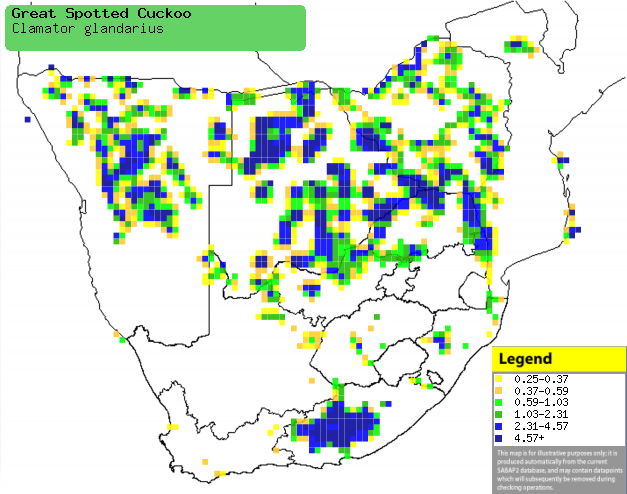|
Clamator glandarius (Great spotted
cuckoo)
Gevlekte koekoek [Afrikaans]; Haya (name also applied to Green
wood-hoopoe - check) [Shona]; Kuifkoekoek [Dutch]; Coucou geai [French];
Häherkuckuck [German]; Cuco-rabilongo [Portuguese]
Life
> Eukaryotes >
Opisthokonta
> Metazoa (animals) >
Bilateria >
Deuterostomia > Chordata >
Craniata > Vertebrata (vertebrates) > Gnathostomata (jawed
vertebrates) > Teleostomi (teleost fish) > Osteichthyes (bony fish) > Class:
Sarcopterygii (lobe-finned
fish) > Stegocephalia (terrestrial
vertebrates) > Tetrapoda
(four-legged vertebrates) > Reptiliomorpha > Amniota >
Reptilia (reptiles) >
Romeriida > Diapsida > Archosauromorpha > Archosauria >
Dinosauria
(dinosaurs) > Saurischia > Theropoda (bipedal predatory dinosaurs) >
Coelurosauria > Maniraptora > Aves
(birds) >
Order: Cuculiformes > Family: Cuculidae
The Great-spotted cuckoo is fairly common across its
scattered range, living in savannas and grasslands. It feeds on a wide variety
of invertebrates, rarely eating reptiles. It only parasitizes crows and
starlings, waiting until the host is not present, before laying 1-4
eggs into its nest. It lays up to 6 eggs in one day, and up to 23 in the whole
season. Unlike some cuckoos, the chicks do not always kill their "siblings", but
will sometimes peck and damage them. It stays in the nest for 22-26 days, the
period after this has not been studied. Interestingly, an adult cuckoo was once
recorded feeding a fledgling.
Distribution and habitat
Occurs in the
Middle east, Spain, Morocco and sub-Saharan Africa, excluding equatorial lowland
forest. In southern Africa it is fairly common in northern and central Namibia,
Botswana, Zimbabwe, Mozambique and northern South Africa, within an isolated
population in the Eastern Cape. It
generally prefers arid, open savanna, particularly with Acacia trees, and grassland
with scattered trees and bushes.
|
 |
|
Distribution of Great-spotted cuckoo in southern Africa,
based on statistical smoothing of the records from first SA Bird Atlas
Project (©
Animal Demography unit, University of
Cape Town; smoothing by Birgit Erni and Francesca Little). Colours range
from dark blue (most common) through to yellow (least common).
See here for the latest distribution
from the SABAP2. |
Call
Food
Feeds mainly on invertebrates -
especially hairy caterpillars but also grasshoppers, beetles and other insects.
It typically forages by
sitting in the tree canopy, scanning the surrounding foliage and ground for
prey. Once prey is located, it swoops into foliage or on to the ground and grabs
its prey. The following food items
have been recorded in its diet:
Breeding
- It is a brood parasite, meaning that it lays its
eggs in other birds nests. The host, thinking that the egg is its own,
incubates the egg and cares for the chick. The following bird species have
been parasitized by the Great-spotted cuckoo:
- Egg-laying season is from December-March in Namibia and Botswana,
August-January in Zimbabwe, October-January in the Kruger National Park and
from October-February in the Western and Eastern Cape.
- The female waits until the potential host has left the nest, then
inspects it to see if it is suitable. If it is, she lays 1-4, usually two eggs,
laying up to six eggs per day and up to 23 in one breeding season.
- Unlike some cuckoos, the chicks do not always kill their "siblings", but
will sometimes peck and damage them. They leave the nest after 22-26 days,
after which they might be fed at least partly by their cuckoo parents (based
on one observation).
Threats
Not threatened, in fact it is widespread and fairly common.
References
-
Hockey PAR, Dean WRJ and Ryan PG (eds) 2005. Roberts
- Birds of southern Africa, VIIth ed. The Trustees of the John Voelcker
Bird Book Fund, Cape Town.
|
